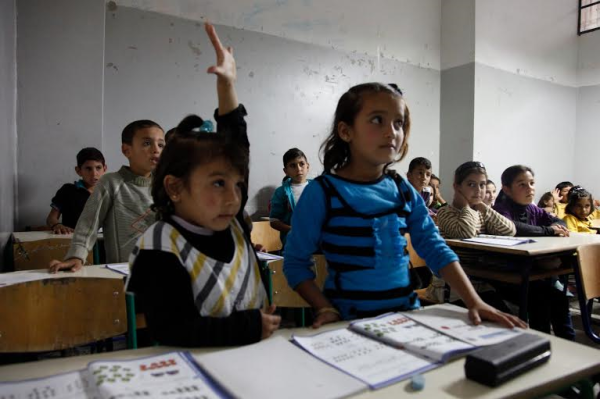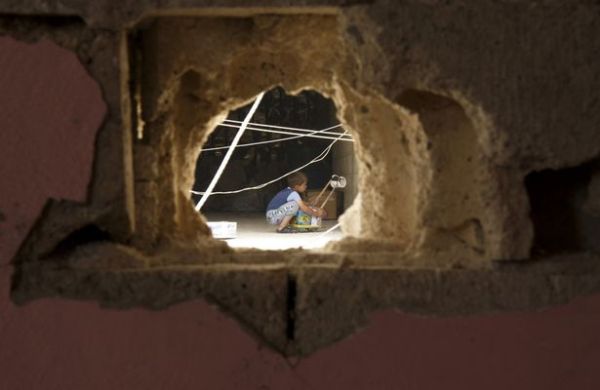
Close to a month has gone by since footage went viral of Prime Minister Trudeau welcoming the first planeload of Syrian refugees at Toronto’s Pearson Airport. Since that time, more than 6000 Canadian newcomers have arrived. Sponsorship groups and settlement agencies are busy supporting families to adjust to their new lives in Canada. According to the updated plan, Canada will welcome an additional 4000 Syrians by mid-January, and another 15,000 by the end of February for a total of 25,000. Even more are slotted to arrive over the course of 2016.
The exact number of children in that first 25,000 is unknown. However, it’s safe to assume that at least half are under the age of 18: the average age in Syria is 18, and according to UNHCR, more than 50% of Syrian refugees are children under the age of 18 – in other words, at least 12,500 will be school-aged.
Can Syrian refugee children realistically start school in Canada? Are we ready for them? And can they start tomorrow?
YES.
Indeed, many of them already have.
It’s hard to put it better than our ambassador to Lebanon, who said goodbye to refugees at the airport in Beirut before they boarded flights to a new home: “In Canada, we believe that your heart is big enough to love Syria and to love Canada.” By properly equipping our classrooms, we can help ensure this is a reality for all of the children in our schools.
Canada has a long history of immigration and refugee settlement. Our current efforts to integrate Syrian refugees – even a population this size, and within these short timelines – are not new. We have been here before. In 1979-80, Canada opened its borders to 60,000 Indochinese fleeing Vietnam. Since 2006, Canada has settled an average of 25,000 refugees each year. Teachers, principals and our wider school communities know a thing or two about what newcomer children and youth bring with them. Below is an overview of the opportunities and challenges alike and a list of resources for teachers. We invite you to recommend other resources below, as well.
Opportunities for Canadian classrooms
Schools are critical partners in promoting the successful integration of former refugees into Canadian society. Teachers, principals and our school communities should recognize refugee children and their families not simply as passive recipients of support but rather permanent residents and active agents in nation-building. Refugees enrich our society, and have a lot to offer our Canadian school communities.
- Strong cultural values for education – Prior to the crisis, school enrollment and literacy rates among Syrians were very high. In 2011, literacy rates for youth aged 15-24 hovered around 95%, and primary school enrollment was 91%. While many children may not have had the opportunity to learn after fleeing Syria, they and their families will be eager to see them return to a classroom.
- The global meets local – While a scan of the average classroom across Canada will tell you this is already happening, the newcomer students can challenge the status quo and expose us to new ideas and ways of doing things.
- Excitement about a new home – It’s always an enriching experience to see life through someone else’s eyes. Rather than focus on the negatives, the newcomer children will no doubt bring a great deal of enthusiasm about their new home and provide us and our children an opportunity to do the same.
- Mentorship and leadership skills development – There are a number of children in Canadian schools who speak Arabic. These children can act as peer mentors/tutors for younger children. At the same time, peer support or “buddy” programs pairing newcomer children with Canadian students can prove mutually beneficial as we saw in one Edmonton school.
Potential Challenges for Canadian classrooms…and top tips!
In a recently-released OECD study on integration issues and education systems, Canada fared quite well compared to other countries. But there is a lot of room for improvement, and we need to be aware of potential pitfalls. Syrian newcomer children possess extraordinary resilience that has seen them through the last few months or years and yet, they will inevitably face a number of challenges when they first enroll in school. They will be reliant on teachers and classmates to help them navigate the new system.
- Psychosocial support needs – There has rightly been a great deal of focus on the psychosocial impact of the crisis on Syrian children. In the field of education in emergencies we know that, on average, only 20% of children coming out of crisis are in need of additional, intensive therapy. This statistic is not meant to undermine the seriousness of the situation but instead points to the fact that a majority of children will be able to thrive in a situation where they are provided with a sense of normalcy – where they feel they are supported, welcome and feel safe. School can provide that, in addition to referrals for those students in need of more support. The Peel District School Board in Ontario, for example, is reportedly working with the Canadian Centre for Victims of Torture to offer referral support.

- Reservations about school – In the last four years more than half of all attacks on schools globally have occurred in Syria. This makes for a total of more than 4,0000 attacks in Syria since 2011[1]. Schools can be targeted because they are public institutions, for promoting what is thought to be non-Islamic education, or because they are occupied by displaced populations from neighbouring communities. This means that even where schools remain open, parents fearing for their children’s safety often keep them at home. This mistrust in the school system has been known to remain even when families have reached safer areas, such as Canada. It will be important to integrate parents in schools as much as children. Innovative opportunities for learning from and supporting these parents could be fostered through establishing parent groups, to better integrate them into the school community such as the ESL classes initiated by parents at a Burbank, California school.
- Language challenges – In Syria, children learn exclusively in Arabic throughout their school career. Many Syrian children arriving in Canada will have spent time in a school system in Iraq, Turkey or Lebanon, where the language of instruction is Kurdish, Turkish, or Arabic with English and French as separate subjects and languages of instruction for math and science only. Overall, many children will have received very little formal education. Language programs like LEAP offered by the Toronto District School Board support students to develop the English language skills needed for success in the classroom. It is important to note, however, that these types of programs should complement regular classroom learning that provides invaluable opportunities for newcomer children to learn along with their Canadian peers.
- Unfamiliar classroom protocol and teaching styles – Interactions with and between teachers and students in a Canadian classroom will be a new experience for Syrian children in many ways. The reality is less than 50% of Syrian children have had the opportunity to go to school since the crisis began. Rote learning is the norm in Syria and other countries along their route to Canada and as such, the more co-operative and participatory approach to teaching and learning in Canada will be an adjustment. Newcomer students may not understand that they are expected to ask questions about lessons and homework or participate in activities, for example. Students and teachers may notice minor behavioural oddities, such as newcomer students looking distracted, walking around the classroom, or hoarding items. The “buddy” system mentioned above can go a long way to give children confidence to approach the teacher. Teachers should also be aware of behavioural challenges and consider discussing one-on-one with students when they first enroll and holding regular “check-ins”.
- Challenge of equivalencies – Fortunately, school boards here in Canada have a great deal of experience with this and yet it is important that we ensure children’s prior learning is recognized and as much as possible, that they be placed in age-appropriate classrooms. Programs such as LEAP must be viewed as a bridging opportunity, not as an indication of ability or low potential. Lack of education is not the fault of these children.
- Policy environment– In addition to changes and accommodation at the school level, the OECD study referenced above recommends institutionalizing changes to support the new influx of Syrian refugee children which at the same time benefit the integration of all children and the wider system. The policy recommendations included are to:
- Establish and sustainably fund language instruction bridging programs;
- Invest in early childhood education – if children enter school at age 2 or 3, studies have shown levels of education attainment the same as those of non-immigrant children;
- Encourage and equip all teachers, not just specialist teachers, to manage the needs of a diverse classroom;
- Avoid concentrating newcomer children in the same disadvantaged schools – look at ways to place less pressure on already overstretched schools and teachers. In the TDSB there is a list of model schools which are better equipped to meet the needs of newcomer students;
- Establish policy and provide support for newcomer parents to engage with their children’s school community.
Resources on refugee education
Dr. Sarah Dryden-Peterson, a Canadian and a professor at the Harvard Graduate School of Education, is a specialist in refugee education both in the countries of origin and asylum. Her work highlights the needs and gaps in the current offerings. Below is a list of appearances, papers, articles and editorials by Sarah drawing attention to this important line of work.
Public Radio International: Closing the borders to refugees also means shutting out children who need a better education
Brookings Education + Development: For Syrian refugee children and youth, education is the front line
Huffington Post/World Post: A Future for Syrian Children: Integration in National Education Systems
Migration Policy Institute: The Educational Experiences of Refugee Children in Countries of First Asylum
And related press: After the Journey: What US Educators need to know about refugee children and how to teach them
Resources for teachers
As part of the Schools Welcome Refugees Initiative profiled earlier on the blog, a group of volunteers put together a comprehensive list of resources for teaching about the refugee crisis and wider issues of global education in the Canadian classroom.
Schools Welcome Refugees Initiative: “Tools for Teaching about Refugee Issues”
Additional resources
These resources include recommendations for supporting newcomer student learning and creating a more inclusive classroom environment.
Block, Karen, Suzanne Cross, Elisha Riggs & Lisa Gibbs. (2014) Supporting schools to create an inclusive environment for refugee students. International Journal of Inclusive Education. Volume 18, Issue 12. 2014
Colorin Colorado: How to Support Refugee Students in the ELL Classroom.
Foundation House – The Victorian Foundation for Victims of Torture: School’s In for Refugees; A whole-school approach to supporting students of refugee background.
Hamilton and D. Moore (eds.) (2004). Education of Refugee Children: Theoretical Perspectives and Best Practice. New York. RoutledgeFalmer. (Available at the Toronto Reference Library.)
Stewart, Jan. (2011). Supporting Refugee Children: Strategies for Educators. Toronto. University of Toronto Press. (Available at the Toronto Public Library.)
Teaching Refugees with Limited Formal Schooling. (A bit dated but a useful resource.)
